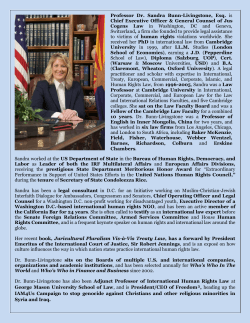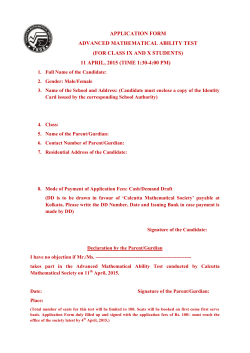
University of Melbourne Department of Economics ECOM90005
University of Melbourne Department of Economics ECOM90005 Advanced Econometric Techniques Semester 1, 2015 Subject Guide Lecturer: Associate Professor Chris Skeels Telephone: 8344 3783 (ext: 43783, if calling on an internal line) Email: Chris.Skeels@unimelb.edu.au Office: FBE Building (#105), Room 327 Office Hours: By appointment (or just drop by) Tutor: Todd Morris Telephone: Please use email for contact. Email: tsmorris@student.unimelb.edu.au Office: FBE Building (#105), Room 558 Office Hours: Thursday 1:00pm–2:00pm Lecture: Monday, 9:00am–12:00pm, The Spot-1022 (Level 1 Theatre) Tutorial: Tuesday, 4:15pm–5:15pm, The Spot - Room 3014 (Computer Laboratory) Timetable: Requirements: Computer exercises, problem sets, allocated reading, and a 2-hour final examination. All continuous assessment will need to be submitted as a pdf document, prepared using LATEX. Some support for LATEX will be provided. Also, the final examination will be held in the Department, outside of the standard University timetable arrangements. Assessment: The computer exercises and problem sets will collectively contribute up to 20% of your final grade with the final examination accounting for the other 80%. Textbooks: This year there is no prescribed textbook. Some students have found Wackerly et al. (2008) helpful on occasion, and the free ebooks provided by Trench (2012) and Bass (2014) may also prove useful. In respect of Matlab, Hanselman and Littlefield (2011) may be of use, although a variety of web-based resources will also be provided. Numerous other references will be provided throughout the course, a selection of which are listed at the end of this document. 1 About the Subject ECOM90005 is a compulsory subject in the first year of our PhD program and an elective available to suitably prepared second year MEc students. Its primary purpose is to ensure that students have sufficient technical skills to read and appreciate current quantitative research in economics. It provides a foundation that is built upon in ECOM90014 Advanced Econometric Techniques 2, where the focus is much more on current econometric practice. Subjects taught at this level, to typically small groups, have the advantage of being responsive to the needs of the current group of students. They also tend to reflect the idiosyncrasies of those teaching them. I fully expect that to be the case this year. There is no single resource that covers everything in the subject and students at this level are expected to read widely as well as attend lectures and tutorials.1 Where available, you should attempt as many problems as you have time for. Only through practice will you master this material. An outline of the major topics is provided below. In an effort to bridge the gap between analytic, closed-form methods and numerical methods, you will also be introduced to a high-level matrix and programming language, Matlab, to provide you with a basis to solve problems which have no closed-form solutions. Computer exercises and problem sets to be handed in for grading will be due every week during the term. These must be handed in at the beginning of the class for which they are assigned due. No late assignments will be accepted. Topics The topics to be covered may include: • Probability and Its Foundations • Distribution Theory • Asymptotics • Principles of Estimation • Principles of Hypothesis Testing Selected Further Reading Abadir, K. M. (1999). An introduction to hypergeometric functions for economists. Econometric Reviews 18(3), 287–330. Abramowitz, M. and I. A. Stegun (1964). Handbook of Mathematical Functions with Formulas, Graphs, and Mathematical Tables. Dover, New York, This book is freely available online at http://people.math.sfu.ca/~cbm/aands/. Amemiya, T. (1985). Advanced Econometrics. Harvard University Press, Cambridge, Massachusetts. 1 The Handbook of Econometrics is freely available on the web at http://www.sciencedirect.com/ science/handbooks/15734412/1 and is a great place to start for most things econometric. 2 Bass, R. F. (2014). Real Analysis for Graduate Students, Version 2.1. homepages.uconn.edu/~rib02005/real.html, with list of errata. http:// Bierens, H. J. (1990). A consistent conditional moment test of functional form. Econometrica 58(6), 1443–58. Bierens, H. J. (2005). Introduction to the Mathematical and Statistical Foundations of Econometrics. Cambridge University Press, Cambridge. Cox, D. R. and D. V. Hinkley (1974). Theoretical Statistics. Chapman and Hall, London. Davidson, J. (1994). Stochastic Limit Theory. Oxford University Press, Oxford. Davidson, J. (2000). Econometric Theory. Blackwell Publishers, Oxford. Davidson, R. and J. G. MacKinnon (1987). Implicit alternatives and the local power of test statistics. Econometrica 55, 1305–1329. Davidson, R. and J. G. MacKinnon (1990). Specification tests based on artificial regressions. Journal of the American Statistical Association 85, 220–227. Davidson, R. and J. G. MacKinnon (1993). Estimation and Inference in Econometrics. Oxford University Press, New York. Davidson, R. and J. G. MacKinnon (2004). Econometric Theory and Methods. Oxford University Press, New York. Erd´elyi, A. (ed.) (1954). Tables of Integral Transforms. Based, in part, on notes left by Harry Bateman, and compiled by the staff of the Bateman Manuscript Project. [A Erdlyi, editor. W. Magnus, F. Oberhettinger, F. G. Tricomi, research associates]. Vol. 1. McGraw-Hill Book Company, Inc., New York. Feuerverger, A. and R. A. Mureika (1977). The empirical characteristic function and its applications. The Annals of Statistics 5(1), 88–97. Fieller, E. C. (1932). The distribution of the index in a normal bivariate population. Biometrika 24(3/4), 428–440. Gallant, A. R. (1997). An Introduction to Econometric Theory: Measure-Theoretic Probability and Statistics with Applications to Economics. Princeton University Press, Princeton, New Jersey. Gradshtein, I. S. and I. M. Ryzhik (2007). Table of Integrals, Series, and Products (seventh edition). Daniel Zwillinger and Alan Jeffrey, editors. Academic Press, Boston. Hanselman, D. C. and B. L. Littlefield (2011). Mastering Matlab. Prentice Hall, USA. Kreyszig, E. (1979). Advanced Engineering Mathematics (4th edition). John Wiley & Sons, New York. Lehmann, E. L. (1986). Testing Statistical Hypotheses (2nd edition). Springer-Verlag, New York. 3 Malinvaud, E. (1970). Statistical Methods of Econometrics (second revised edition). North Holland Publishing Company, Amsterdam. Marsaglia, G. (1965). Ratios of normal variables and ratios of sums of uniform variables. Journal of the American Statistical Association 60(309), 193–204. Neyman, J. and E. S. Pearson (1933). On the problem of the most efficient tests of statistical hypotheses. Philosophical Transactions of the Royal Society of London. Series A, Containing Papers of a Mathematical or Physical Character 231, 289–337. Phillips, P. C. B. (1982). Small Sample Distribution Theory in Econometric Models of Simultaneous Equations. Cowles Foundation Discussion Papers 617, Cowles Foundation for Research in Economics, Yale University. Phillips, P. C. B. (1983). Exact small sample theory in the simultaneous equations model. In Z. Griliches and M. D. Intriligator (eds.), Handbook of Econometrics, Vol. 1, Chapter 8, pp. 449–516, North Holland, Amsterdam. Rao, C. R. (1973). Linear Statistical Inference and Its Applications (2nd edition). John Wiley & Sons, Inc., New York. Silvey, S. D. (1959). The Lagrangian multiplier test. Annals of Mathematical Statistics 30(2), 389–407. Silvey, S. D. (1970). Statistical Inference. Chapman and Hall, London. Siotani, M., T. Hayakawa, and Y. Fujikoshi (1985). Modern Multivariate Statistical Analysis : A Graduate Course and Handbook. The American Sciences Press series in Mathematical and Management Sciences. American Sciences Press, Columbus, Ohio. Slater, L. J. (1960). Confluent Hypergeometric Functions. Cambridge University Press, Cambridge. Slater, L. J. (1966). Generalized Hypergeometric Functions. Cambridge University Press, Cambridge. Theil, H. (1971). Principles of Econometrics. John Wiley and Sons, New York. Trench, W. F. (2012). Introduction to Real Analysis (hypertext edition). William, F. Trench, Department of Mathematics, Trinity University, San Antonio, Texas. http: //ramanujan.math.trinity.edu/wtrench/misc/index.shtml. Wackerly, D. D., W. Mendenhall, and R. L. Scheaffer (2008). Mathematical Statistics With Applications (7th edition). Thomson Brooks/Cole, Belmont, CA. Yu, J. (2004). Empirical characteristic function estimation and its applications. Econometric Reviews 23(2), 93–123. 4
© Copyright 2025

![COO3A1 Econometrics for Finance [4 Credits] Learning Objective](http://cdn1.abcdocz.com/store/data/001102196_1-a1bfcbf696b2dde07865cdb8e2e08339-250x500.png)














